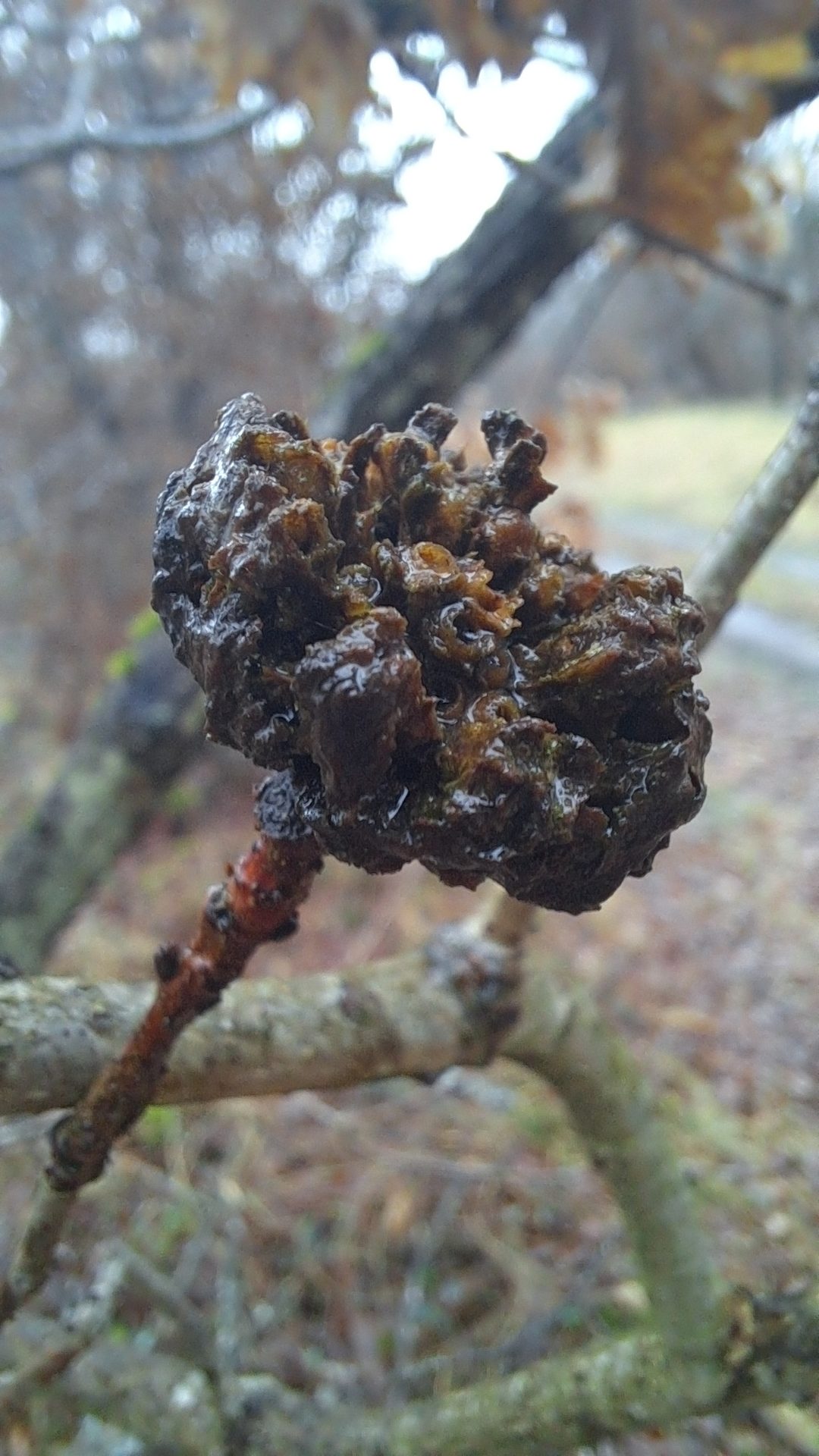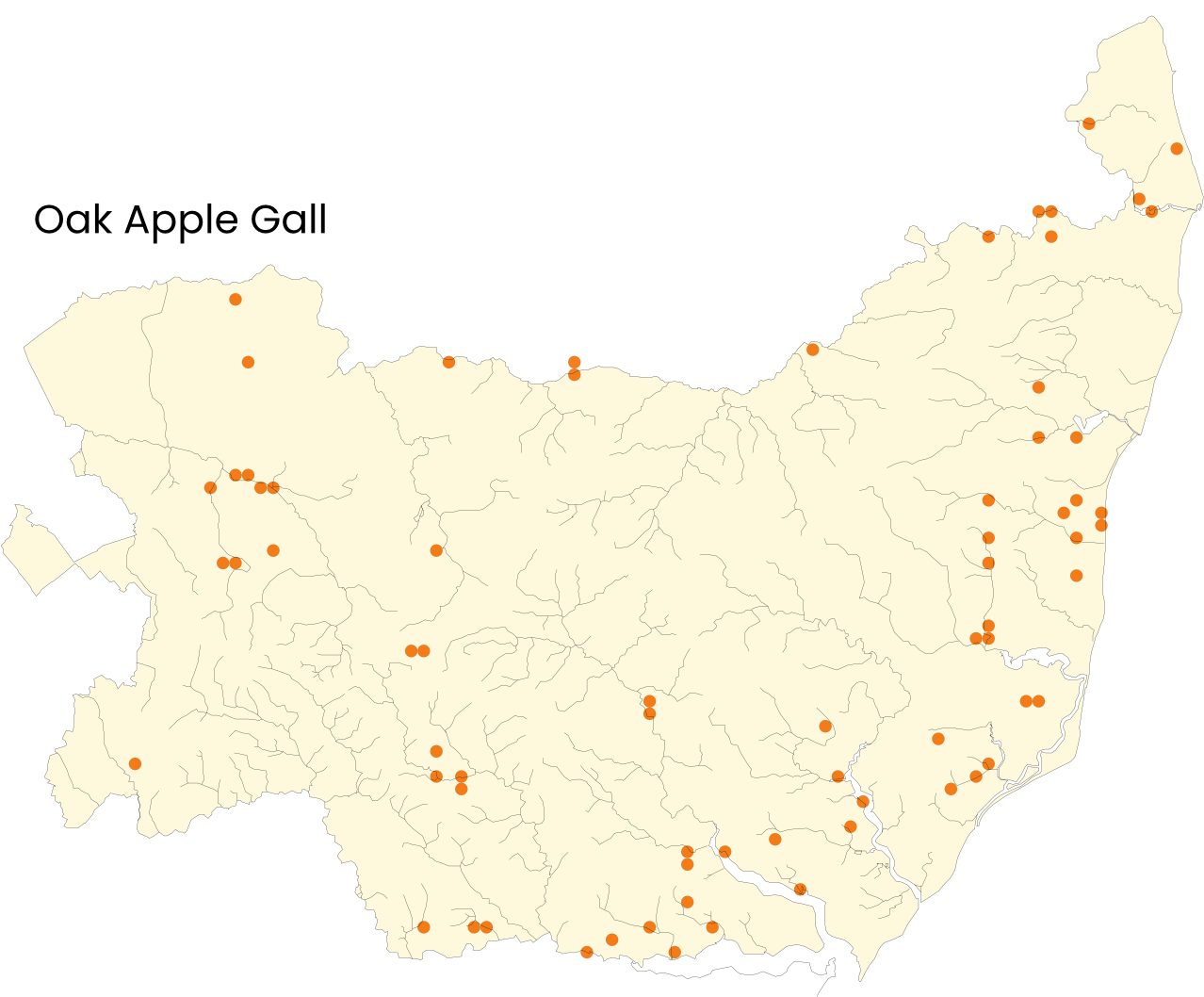Before their unusual lifecycle was discovered, the two generations of Oak apple gall wasps were believed to be separate species, Biorhiza pallida and Biorhiza aptera, due to the difference in their appearance.
Sally Jennings
Galls are growths found on plants, made of plant tissue but caused by another organism, in this case, the Oak apple gall wasp. By making an oak tree develop galls, the wasps can use the plant for their own purposes. It is a one-sided, parasitic relationship, as the oaks receive no benefit. However, the galls don’t cause any harm to them.
© Sally Jennings, Flickr
Description: Galls
The galls usually grow to about 20-45mm in diameter. However, sometimes several wasps lay their eggs in the same leaf bud, resulting in a larger gall. When the galls are still small, the original leaf bud scales can still be seen at their tip.
©Antoine Guiguet, iNaturalist

They are spongy, pale pinky-brown and roughly spherical. Their outer layer has a similar texture to the skin of a mushroom. Galls darken and dry as they age, then become woody once the larvae have hatched.
© Jean Marie Frenoux, iNaturalist
Sally Jennings
Wasps from the all-female generation are wingless and reach 4.8–6.3 millimetres long. They have a golden brown head, mid-brown eyes, and orange ocelli (simple eyes). Their antennae are long, orangeish-brown, with fifteen segments. Their thorax, legs, and bulbous, glistening abdomen are yellowish-brown.
© Zmrdk, Flickr
Description: Wasps
Wasps from the male/female generation are about half the size of those from the all-female generation at 2–3.5 mm long. Their head, thorax and abdomen are a translucent golden brown. They have transparent wings with dark veins and pale brown hairs. Females have large, dark eyes, and males have pale eyes. Their abdomens are also different: deep and narrow in the male and broad and tipped with an ovipositor in the female.
© Kim Falck, iNaturalist

They are common across the UK and widely distributed across Suffolk.
Distribution in Suffolk
© Sally Jennings, Flickr
Did you know?
Oak Apple Day, 29 May, has been celebrated in some parts of the UK for over 350 years. It began as a commemoration of Charles II’s restoration to the throne in 1660 after he hid in an oak tree to avoid capture during the English Civil War.
Lifecycle
© Martin Grimm, iNaturalist
X
CLOSE
- Androphore’s eggs become males
- Gynophore’s eggs become females
- Gynandrophore’s eggs become male or female
Oak apple gall wasps have a fascinating lifecycle, alternating between an all-female generation and a male/female generation.
An all-female generation hatches from small galls in the oak’s roots in spring. They reproduce asexually, laying fertile eggs without needing a mate and have three reproduction types: androphore, gynophore and gynandrophore.
They are wingless and must climb up the trunks to reach the leaf buds, where they will lay their eggs. They often choose a bud larger than its neighbours on a shoot from the previous year, which they favour over older shoots.
They bite into the bud and inject a pungent secretion, which softens the leaf tissue and stimulates the growth of a gall. They can lay up to 300 eggs in the softened bud, but typically, they will lay around 80.
Hatching starts in April, and the larvae eat the surrounding plant tissues. Eggs and larvae secrete the same chemicals as the adult females, that changes how the bud grows and causes a gall to form instead of leaves.
© Andrew Thomas, iNaturalist
© Fabien Piednoir, iNaturalist
Each larva has its own chamber inside the nutritious and protective environment formed by the gall. Studies show that around 64% of the galls contain female wasps, 22% males, and the rest contain male and female wasps.
After two to three months, from the end of May through to July, the larvae emerge from the safety of the gall to begin their adult life. In July, after mating, females make their way into the soil to lay a single egg inside the tiny rootlets of the oak tree.
Their larvae develop inside small pea to marble-sized galls growing on the tree roots. Initially, the root galls are pale, soft and juicy, darkening from pink to red to dark brown as they age, then becoming hard and woody.
These larvae develop very slowly, taking around eighteen months to reach maturity. A new generation of wingless females emerges in the second winter or spring after the eggs are laid.
© Malcolm Storey, Bioimages.org.uk
Oak marble gall
A woody spherical gall that grows to 25mm in diameter. Attached to twigs at the base of leaves. They are initially green but then become brown and can last for several years. They have small round holes where the wasp has emerged.
Credits
With thanks to Jerry Bowdrey, the Gall recorder for the Suffolk Naturalists’ Society.
Lifecycle details taken from: Urban, J. (2019). Contribution to the Knowledge of Incidence, Development and Galls of the Bisexual Generation of Biorhiza pallida (Hymenoptera: Cynipidae). Acta Universitatis Agriculturae et Silviculturae Mendelianae Brunensis, 67(3), 771-785. doi: 10.11118/actaun201967030771
You might also see

© Christian Kahle, Flickr
Spotting them
When to see them: year-round.
Remember to record your sighting if you spot them in Suffolk!
© Fahrenheit 66, iNaturalist

